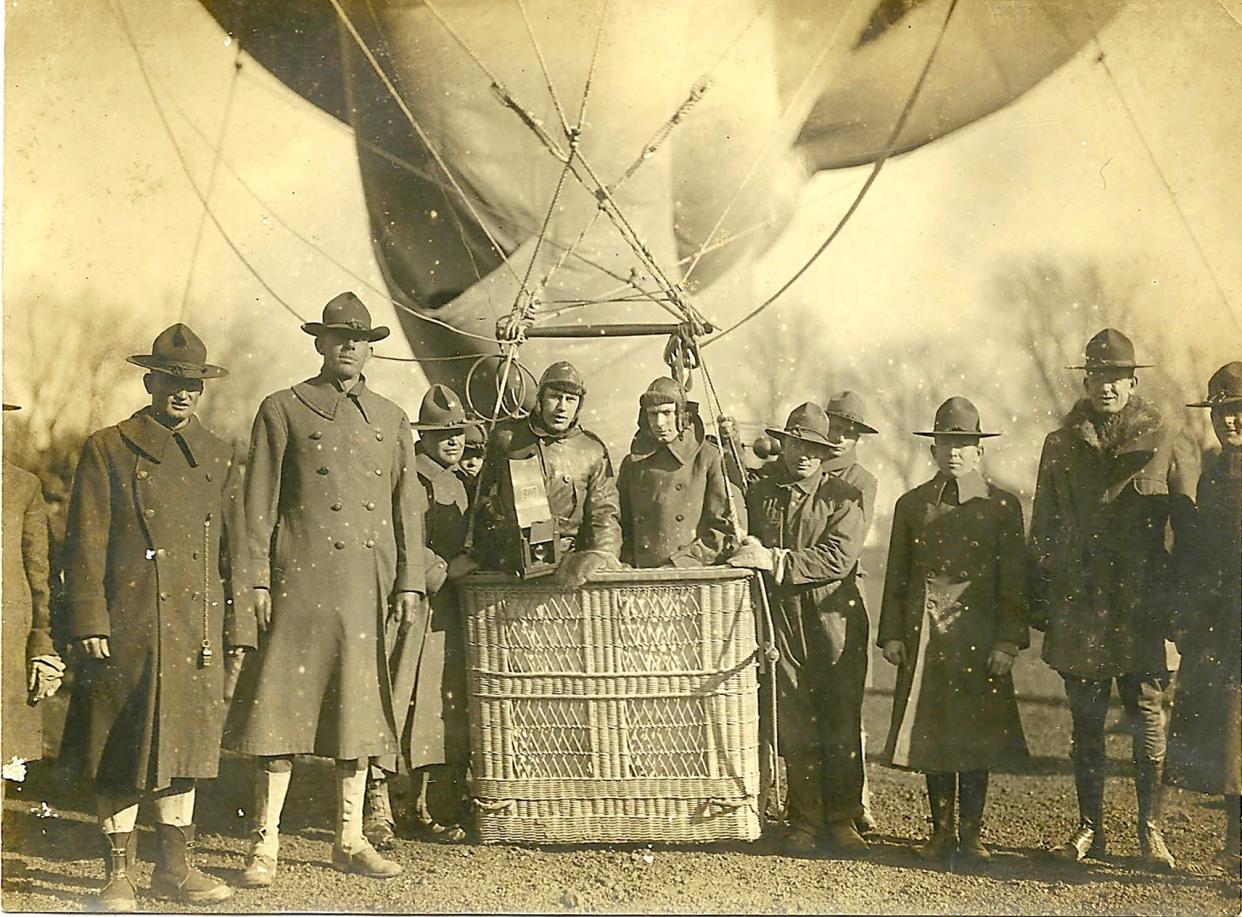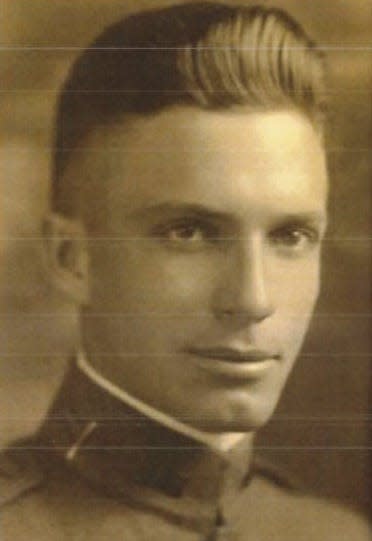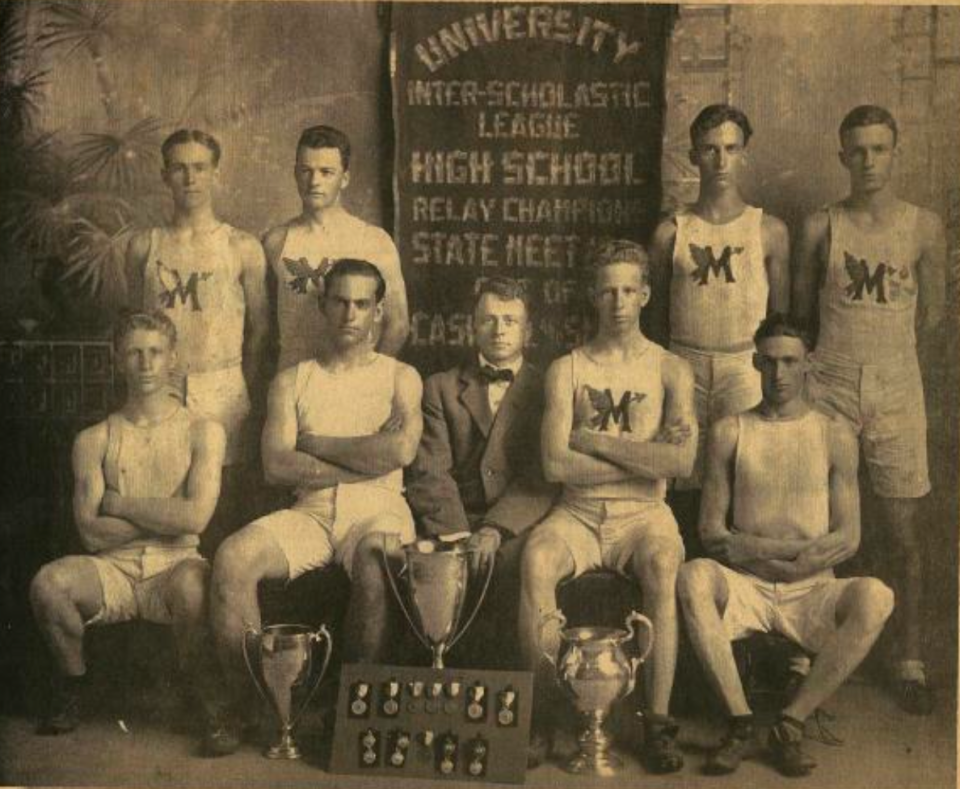Revisit Congress Avenue in 1914, where revelers in cars crowd out horse drawn buggies

You don't have much time before Father's Day, which falls on June 16 this year, to match the magnificent gift given by a Texas man, originally from Marlin, who came close to immortalizing his father.
Jack Robertson, 81, uncovered a treasure trove of old Texas documents, essays, letters, photos and other ephemera in a box of memorabilia that had belonged to his father, Rupert Robertson (1895-1968).
A University of Texas professor emeritus of accounting, Jack recognized the historical value of Rupert's descriptive essays written for his English classes at UT from 1914 to 1916, as well as the evidence from his military service during World War I, when Rupert was a balloonist.
Since the elder Robertson starred on the Marlin high school track team and earned his track letter at UT in Austin, his son Jack wanted to preserve his father's writing at the university's Lutcher Stark Center for Physical Culture and Sports, a marvelously eccentric museum and archive tucked into the north end of Royal Memorial Stadium.
Terence "Terry" Todd, the late director of the Stark Center, and his wide, Jan Todd, current director, welcomed Rupert's personal papers, many from more than 100 years ago.
"Terry asked me to include a biography of my father, so independent researchers could add the personhood of the author to the context of the stories," Jack says. "Ten months and 62 pages later, I delivered the biography."
You read that right, the dutiful son produced a biography of his father that weighs in at 62 single-spaced pages, which, while short of being a book, is much more than a bio sketch.
I can't pretend to have read every word of this opus, but combined with Rupert's own writing, the world of Texas in the early 20th century became incrementally clearer to me through this gift from Jack Robertson.

A choice essay on Austin from Rupert Robertson
In 1914, Rupert Robertson wrote the following essay about a night on Congress Avenue, one of many he executed for English classes at UT. Note the keen details as Rupert's attention wanders — through various sentence structures — from one sensation to another. This was a time when most of the city's commercial traffic and entertainment venues were concentrated on Congress, but before the Paramount Theatre opened as the Majestic Theatre in 1915.
This particular personal anecdote — and others like it from all over the state — is available digitally to the public at thestoryoftexas.com through the Bob Bullock Texas State History Museum as part of the "Help Us Tell the Story of Texas" project.
"The rain is coming down slowly, and it wets the street so that it glistens under the big arc lights like a large mirror.
"The red and yellow drays are bespattered with mud. The streetcars, automobiles and other vehicles are rumbling down the street with such a terrible drum that I would think I was by myself if I could not see the throng of people moving up and down the street.
"Some are gazing at the beautifully lighted show windows which contain various shades of the latest styles of clothing; some are on the inside of the store purchasing articles, and some are looking at the red, white and green moving picture signs, and debate with themselves whether to go in or stay outside and parade the street with the "mob."
"The crowd is composed mostly of university students, but they are not in a hurry tonight. This is unusual, because as a general rule, these fellows are restless, and always go with push and vim wherever they are. But the college spirit is here, for every now and then I hear the jolly laugh of some young man at the joke or remark of one of his companions.
"Boys and girls in couples, clad in their grey and brown rainproof garments, are present in great numbers. There is an air of happiness and success among them as they go down one side of the street and come up the other; the thought of the green-back English book and the brown cloth-covered mathematic text is left behind and forgotten.
"The crowd is divided into groups which represent different fraternities, clubs and various other organizations. Each individual bunch has a characteristic of its own. The Rusticusses wearing big hats, the Phi Gamma Deltas grey mackinaws with a blue stripe, the Sigma Nu's ties, and the other organizations have some similar distinction.
"The rest of the crowd is compiled of town girls and boys; brown (Mexican American); Negro men and women; and a great part of the Jewish population. Here and there, and at every corner, I see a policeman watching the crowd as a cowboy on horseback watches a herd of cattle.
"The street is as crowded with vehicles as the sidewalks are with people. Along the curbing are many automobiles with their radiators pointing toward the crowd and the rear ends toward the middle of the street. At intervals are found horses and buggies, but not many because automobiles are rapidly taking their place.
"Then there are the candy vendors in their dingy clothing, selling brown peanut and pecan candies. The popcorn man has his wagon driven close to the curbing, and is selling chewing gum, peanuts and pink popcorn. The whole scene has an atmosphere of relaxation and freedom in spite of the gloominess of the weather."

Rupert Robertson the athlete
"After starting the biography," Jack Robertson writes, "I needed to continue to the end."
Rupert Cook Robertson was born March 31, 1895 in the rural town of Kosse, Texas (pop. 500) in southern Limestone County. His father, Charles Onward "C.O." Robertson was born in Alabama in 1867; his mother Martha Adeline "Mattie" Price Robertson, was born in Blue Ridge in Falls County in 1872.
Rupert was known as a "city boy" in Kosse, where his family owned a general store, but he spent much time on his grandfather's Price's farm in Falls County, where "all activity revolved around the fields and seasons."
Even in the early 20th century, rural Texas remained closer to the rhythms of the 19th century. "His transport was shoe-leather and horse-and-buggy," his son writes. "His water came from a well. His sanitation was the outhouse. His entertainment was outdoors with family and friends."
Socially, this was the "segregated South," with scant interaction between the races, other than the employer-worker relationships, Jack reminds readers.
Rupert was not the only Kosse native to make it big in sports. David E. "Kosse" Johnson Jr. starred as a halfback on the Rice Institute team during the 1950s and was drafted by the Green Bay Packers.
Another nearby exposure to big-time sports: Pro baseball teams — such as White Sox, Cardinals, Reds, Athletics and Giants — held spring training camps in nearby Marlin, which attracted flocks of tourists because its mineral water that promised reputed healing properties.
Rupert attended Marlin High School from 1912 to 1914. He lived in a boarding house operated by his Aunt Clara Belle Price. Even today, one can walk by blocks and blocks of sizable Victorian and farmhouse-style homes in Marlin.
Since his father disapproved of football, Rupert ran track. State high school track meets were held at UT's Clark Field beginning in 1905. The big four regional teams were Belton, San Antonio, Austin and Dallas. According to University of Texas Interscholastic League records, Marlin competed strongly from 1910 to 1915, and the school earned the top spot in 1914. As usual, Rupert won individual and team medals. (Jack's documents on these events are startlingly detailed.)
When Rupert entered UT in 1914, Austin was home to about 30,000 people, and 2,300 of those were members of the university's student body. His freshman class, for which he served as secretary-treasurer, counted 674 members.
Rupert said he wanted to study business in order to take over the family general store in Kosse. Jack always imagined that his father was recruited for his track skills, but he also turns up evidence of family and friends who had attended UT, and would have supported Rupert collegiate aspiration. He belonged to that generation of Texans whose families had survived pioneer life in the country and saw brighter horizons for their children in the cities and through higher education.
Rupert joined an athletic fraternity, Sigma Delta Psi, as well as Kappa Alpha, which includes among its brothers athletes who were Rupert's friends. Sports were already big on campus and getting bigger. Folks like Billy Disch, L. Theo Bellmont and Clyde Littlefield led what was becoming a dominant college power in football, basketball, track, tennis, gymnastics, wrestling and soccer — Rupert played wing on the soccer team. In track, he did well in high hurdles, mile relay and other events.
Life in the military and its aftermath
UT sports hollowed out, however, once the U.S. entered World War I on April 6, 1917. Athletes were among the first to enlist and the campus opened military training centers, which were later badly stricken by the flu epidemic in 1918-1919.
Rupert enlisted in the Army on Aug. 5, 1917 in Houston. Much of what he wrote about his first months is fairly anodyne but still illuminating about Austin and San Antonio, where he trained at Camp Travis, during the war. (For instance, Rupert did not pause his habit of dating campus beauties.) After basic training, he was assigned to Fort Omaha, Nebraska, on March, 26 1918 to enter the balloon school. He qualified to be a spherical balloon pilot.
Rupert's family expressed concern whenever the press reported balloon any accidents and explosions, but young man made it through two years in the corps unscathed. He skipped the flu, too, at a time when the military was among the hardest hit sectors in the U.S. by the pandemic. Aug. 30, 1918, Rupert was commissioned as a second lieutenant in the Air Service. After a series of service flights, he was honorably discharged on Aug. 11, 1919 with bronze victory button.
The rest of Rupert's young adult life was spent working in real estate, insurance and various other Kosse businesses, as well as farming citrus fruit and working for firms in the Rio Grande Valley, Corpus Christi and California. In the Valley, he met and married widow Lois Lucille Rose Bartlett; they produced Sara Ellen Robertson Moore and Jack Robertson.
Rupert suffered from various medical conditions, including diabetes and depression, some of them traced to his military service. Lois taught school and the family eventually moved to Marlin, where Jack grew up. A good deal of the remaining personal history consists of Jack's childhood memories of his family while growing up there. (We'd need another column or two to do that part justice.)
Rupert died Jan. 10, 1968 at age 72.
Michael Barnes writes about the people, places, culture and history of Austin and Texas. He can be reached at mbarnes@gannett.com. Sign up for the free weekly digital newsletter, Think, Texas, at statesman.com/newsletters, or at the newsletter page of your local USA Today Network paper.
This article originally appeared on Austin American-Statesman: Much of Rupert Robertson's story focuses on athletic and military life

